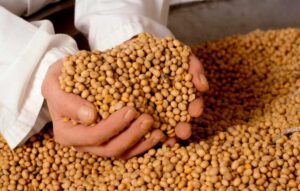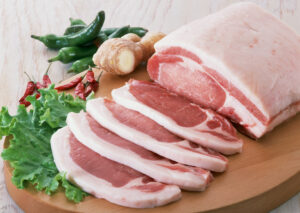
The Bila Romashka pharmacy chain (part of Fozzy Group) opened its first wellness space in the village of Lisnyky near Kyiv on Thursday, the company’s press service reported.
“We have created an offline space that differs from a regular pharmacy or cosmetics store with a special assortment that previously could only be ordered online,” explained Natalia Smaglyuk, CEO of the Bila Romashka chain, whose words are quoted in the release.
The new Bila Romashka space is an offline store for health and beauty products with a wide selection of certified dietary supplements, vitamins, CBD, natural skincare cosmetics, hygiene products, and balanced nutrition products. Currently, the assortment includes almost 2,000 items from 43 brands from the US, France, Korea, Spain, Greece, and Ukraine. Among them are Thorne, Solaray, Nature’s Way, Apivita, Weleda, Now, VVBETTER, Dr. Althea, Panfruit, The Elements, and others. The store will also exclusively feature products from the Ukrainian brand Vitalis Balance. The entire range has been carefully selected by specialists with pharmaceutical expertise.
A consultant will work alongside the pharmacist in the store.
The Bila Romashka pharmacy chain (Fozzy Farm LLC) was established in 2001 and is part of the Fozzy Group. Currently, the chain has 95 pharmacies and one wellness space in 47 locations across Ukraine.
According to YouControl, at the end of the third quarter of 2025, the company received a net income of UAH 1.1 billion, which is 25% higher than in the same period last year, and its net loss amounted to UAH 110 million 567 thousand against UAH 61 million 708 thousand in the third quarter of 2024.
Forecast of changes in discount rate of National bank of Ukraine, %

Source: Open4Business.com.ua

The Cabinet of Ministers has adopted a resolution introducing a mechanism for monitoring soybean and rapeseed exports, according to the press service of the Ministry of Economy, Environment, and Agriculture.
“We are introducing a transparent mechanism that allows producers, rather than intermediaries, to be exempt from export duties. The funds that the state will receive from traders’ duties will replenish a special budget fund and will be directed to programs to support frontline territories, where farmers work in the most difficult conditions, grants for processing, greenhouses, orchards, and insurance against military risks,” said Deputy Minister of Economy, Environment, and Agriculture Taras Vysotsky, whose words are quoted in a statement on the ministry’s website.
The Ministry of Economy noted that the document aims to ensure the fair application of export duty exemptions for certain categories of agricultural producers.
The new procedure establishes a monthly monitoring mechanism to be implemented by the Ministry of Economy to verify the compliance of exported product volumes with the data contained in the State Agrarian Register (SAR) regarding the actual products grown. If discrepancies are found between the declared and actual volumes grown, the Ukrainian Chamber of Commerce and Industry is obliged to cancel the expert conclusions.
“The introduction of such a mechanism ensures that only those exporters who have actually grown the products themselves will benefit from the exemption from export duties,” the ministry added.
The resolution ensures transparent and fair administration of the export duty exemption, prevents abuse during the export of soybeans and rapeseed, provides equal and fair conditions of competition for agricultural producers, and ensures state support for farmers, as only traders, not producers, will pay the duty, the statement said.
The government’s decision is expected to strengthen state control, ensure targeted budget revenues, and contribute to the stability of the agricultural sector. Monitoring will make it possible to simultaneously support conscientious producers and guarantee the replenishment of a special fund for the implementation of key agricultural development programs.
As reported, in September 2025, a law was passed introducing a 10% export duty on soybeans and rapeseed. Agricultural producers and cooperatives that export their own products are exempt from paying the duty. The duty is paid by traders and other exporters who are not producers. The mechanism is aimed at supporting farmers, stimulating domestic processing, and filling a special state budget fund to finance agricultural programs.

Omnichannel electronics and home appliances retailer Foxtrot recorded a 2.6-fold increase in total turnover and a 215% increase in online sales compared to the previous week during Black Friday (November 24 to December 1), according to the retailer’s press service.
Traffic on Foxtrot.ua during this period also increased 2.6 times (week-on-week) and 1.5 times year-on-year; the average check was UAH 9,348 (+134%). The longest check had 43 items, and the most expensive purchase was UAH 630,000 (Samsung QE115QN90FUXUA TV).
“We saw how many buyers were preparing for Black Friday in advance, planning their spending and waiting for discounts. Therefore, we focused on what is really important: to fully meet these expectations by offering the best prices of the year, a wide range of promotional items, free delivery, affordable loans, and high-quality service even in difficult times. And it was this approach that allowed us to achieve decent results in this “sprint,” commented Yuriy Polishchuk, CEO of the Foxtrot chain, whose words are quoted in a press release.
The retailer noted that buyer behavior differed depending on the region. Western regions saw a noticeable uptick starting on Monday, with sales tripling, while shoppers in the center and east became more active in the second half of the week. The highest demand across the country was on Sunday, when the chain recorded its highest sales growth.
The number of active users of the Foxtrot mobile app increased by 176% compared to last year. The top five cities in terms of the number of online orders remain unchanged: Kyiv, Lviv, Dnipro, Odesa, and Kharkiv.
In terms of product categories, smartphones took first place in terms of sales: their sales more than doubled, with premium brands, such as Samsung and Apple, being the most popular.
Televisions, a category that had been declining for several years due to power outages, grew fivefold in turnover and fourfold in the number of units sold compared to a normal week. Large 100-115-inch OLED/QLED/miniLED models were particularly in demand.
Game consoles became another “star” of Black Friday. In three days, Foxtrot customers bought as many PS consoles as they did in half a month last year, or 2.2 times more than in a typical week. Laptops showed the expected growth (threefold), as did vacuum cleaners and built-in appliances, slightly ahead of multi-ovens (fourfold growth) and coffee machines and kitchen combos (3.5 times), while refrigerators and washing machines only doubled.
The trend of the season is “home sets.” Customers bought several items at once: from chargers and headphones to large appliances in a single transaction. Increased demand for charging stations, generators, and power banks has continued for the second month in a row—for this category, Black Friday actually started on October 10.
Accessories and tableware are usually the drivers of sales in quantitative terms on Black Friday, so here the retailer saw its traditional growth – almost threefold. Frying pans and saucepan sets were the most popular purchases.
More than 65% of all purchases were made through the seller’s mobile app. Another indicator of behavioral change is the payment structure: 54% of all sales were cashless. At the same time, almost half of these transactions (47%) were accepted by sellers directly in the sales area: through Tap to Phone, which was scaled across the entire network just before Black Friday (14%), personal POS terminals (32%), and digital payment methods such as LiqPay (2%).
The availability of extended credit programs (up to 24 months) also had a significant impact on demand dynamics: the share of credit purchases rose to 40% of all sales, which is 10% higher than usual.
The release notes that the main technological breakthrough of the year occurred in communications: AI consultants took over some of the routine inquiries. As a result, the share of chat dialogues successfully closed with the help of artificial intelligence increased more than 6 times (+622%) compared to the same period last year, or 28% of all inquiries. In addition, the Foxtrot contact center worked not only as support, but also as a powerful sales channel. The number of orders placed by operators increased by 54%.
Foxtrot is one of Ukraine’s largest omnichannel retail chains in terms of the number of stores and sales of electronics and household appliances. As of November 2025, the company operates 127 stores in 67 cities, the Foxtrot.ua online platform, and the mobile app of the same name. During 2025, the chain added four new stores: in Chabaniv and Brovary in the Kyiv region, in Odesa and Kryvyi Rih, and modernized five retail outlets.
According to Opendatabot, the revenue of FTD-Retail LLC (Kyiv), which develops the chain, amounted to UAH 14 billion 882.632 million at the end of 2024, which is 17.6% more than in 2023, and its net profit was UAH 6 million 721 thousand against UAH 314 million 436 thousand, respectively.
In the first half of 2025, the company received UAH 7.3 billion in revenue and UAH 66.5 million in net losses.
The founders of the omnichannel retailer Foxtrot are Ukrainian businessmen Gennady Vykhodtsev and Valery Makovetsky.

Purchase prices for live pigs next week (December 8-14, 2025) will decrease and amount to 70-71 hryvnia/kg (-5.4%) compared to 74-75 hryvnia/kg this week, according to the Meat Industry Association.
Experts noted that the decline in purchase prices for pork is occurring against the backdrop of growing epizootic pressure in both Ukraine and Europe.
The first outbreak of ASF in Spain in 30 years and the blocking of some of its export certificates have shown that ASF is no longer a local problem but has become a continental threat capable of influencing market expectations and regulatory decisions throughout Europe, the industry association stressed.
“For Ukraine, the main driver of price pressure remains the internal situation — an increase in the number of outbreaks and forced sales of livestock, which creates excess supply,” the association explained.
It cited data on European countries and noted that on the German VEZG exchange, experts forecast prices for half-carcasses of standard pigs at EUR1.60 per kg (78.75 UAH/kg excluding VAT) for the coming week, and EUR 0.80 per kg (UAH 39.38/kg excluding VAT) for half-carcasses of sows. On the Polish exchange CennikRolnicze, the average price for live pigs is PLN 4.61/kg (UAH 53.48/kg). The price range for live pigs is PLN 4.00-5.50/kg (UAH 46.4-63.8/kg).
“Pork from Ukraine could take its place in the global market and stimulate the development of the meat industry and pig farming in Ukraine,” the industry association concluded.

Consumer priorities of Ukrainians have changed, since the beginning of the full-scale war, 47% of respondents have reduced spending on the main categories of consumption, according to the press service of Gradus.
At the same time, 85% noted that they try to maintain a mental balance, allowing themselves occasions for joy and pleasure. This trend is most pronounced in the 25-34 age group, while people 45-55 and 55+ years old are more inclined to save money.
Regarding methods of reducing spending, 82% avoid unnecessary things but do not deny themselves things that bring pleasure, 77% try to buy fewer things but better quality, 76% invest in health, 59% are willing to spend on things that improve emotional well-being and 52% direct funds to development and experience (study, travel).
Ukrainians consider health and medical services to be the most important item of expenditure that should not be saved on (70%).
As for expectations from fashion & beauty-brands – Ukrainians now put quality and durability of things in the first place (39%), and prestige – in the last place (11%).
As for luxury goods, the opinions of respondents are divided. Restraint in buying such things was reported by 32% of respondents. The answer options “it is an excess, which is out of time now” and “are not interested in luxury goods at all” were chosen by 22% and 18% respectively. At the same time, 19% of respondents called luxury goods “a component of normal life, which allows you not to lose yourself”.
In general, women are less inclined to reduce spending on most categories. The reluctance to save money on things that are important to themselves was reported by 61% of women and 47% of men, while goods that improve emotional well-being continue to be purchased by 70% of women and 50% of men.
The research “Consumer pragmatism: how the war has changed our consumption” was conducted by research company Gradus in partnership with Vogue Ukraine specially for the Forces Of Fashion 2025 conference, by self-completion of the questionnaire in the Gradus mobile application. Target audience: men and women aged 18-60 with an above average income, living in Ukrainian cities with a population of more than 50 thousand people, excluding temporarily occupied territories and zones of active hostilities. The field stage lasted from August 25-27, 2025. Sample size: 600 respondents.